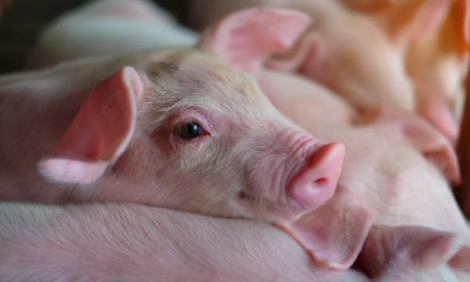



US Pork Outlook Report - October 2005
By U.S.D.A., Economic Research Service - This article is an extract from the October 2005: Livestock, Dairy and Poultry Outlook Report, highlighting Global Pork Industry data.
September 1 Swine Inventories Largely Steady While Productivity Soars
Hogs/Pork:
The Quarterly Hogs and Pigs report, issued by the U.S.
Department of Agriculture (USDA) on September 30 showed September 1
inventories of market hogs and animals kept for breeding to be about
unchanged from a year ago. Modestly higher farrowing intentions for the
December-February quarter, and expected trend increases in litter rates and
dressed weights, point to commercial pork production of 21.1 billion pounds
next year, an increase of about 2 percent from expected 2005 production. The
price of 51-52 percent lean (live equivalent) hogs is expected to average
between $43 and $47 per hundredweight (cwt) in 2006.
Quarterly Hogs and Pigs Report: Numbers Largely Steady While Productivity Soars
The Quarterly Hogs and Pigs report, issued by USDA on September 30
(http://usda.mannlib.cornell.edu/reports/nassr/livestock/php-bb/) reported
September 1 inventories--market hogs and animals kept for breeding--to be about
unchanged from a year ago. The largest positive year-over-year inventory changes
reported were the 1-percent increases in the middle weight categories--60-119
pounds, and 120-179 pounds--of the market hogs and pigs breakout by weight
groups. The inventory of animals in the 180 pounds and over category was reported
to be 2-percent lower than a year ago. Such modest inventory changes--particularly
in breeding animal numbers--raise questions in light of the historical tendency of
the U.S. pork industry to increase inventories after extended periods of positive
returns. The Economic Research Service has reported positive returns in its series
of estimated returns for North Central hog farrow to finish operations in 21 of the
last 22 months.
The Quarterly Hogs and Pigs report also showed a continuation of increases in
litter rates, suggesting that producers may be investing profits in improved
reproductive technology, rather than in additional facilities and animal numbers.
The September report showed June-August pigs per litter at 9.07, a significant
increase from the 9.01 of June-August 2004. The figure below shows that recent
litter rates are a continuation of a positive efficiency trend in U.S. hog production.

2006 Pork Production To Increase Almost 2 Percent in 2006
Modestly higher (first) farrowing intentions for the December-February quarter, and
expected trend increases in litter rates and dressed weights, point to commercial
pork production of 21.1 billion pounds next year, an increase of 1.9 percent from
expected 2005 production. With expectations for continued reductions in 2006 U.S.
pork imports (-2.5 percent, year-over-year), increases in U.S. 2006 pork exports
(+1.3 percent, year-over-year), and slightly higher per capita consumption of 50.1
pounds (retail basis), the price of 51-52 percent lean (live equivalent) hogs is
expected to average between $43 and $47 per cwt in 2006. Retail pork prices next
year are expected to decline about 2-3 percent year-over-year. Retail prices are
expected to average in the high 2.70s per pound.
Pork Exports Seasonally Lower
U.S. companies exported 199.812 million pounds of pork products in August, a
lower quantity than July, but 30 percent larger than August 2004. On a year-to-date
basis, U.S. pork exports are running almost 27 percent ahead of the same January-
August period last year.
U.S. pork exports usually slow during the summer months when U.S. pork prices
typically achieve their annual highs. This year July exports were unexpectedly
large when Japan avoided triggering the Safeguard in the first quarter of its (April-
March) fiscal year for the first time in 5 years, creating additional demand for
imported pork products. U.S. pork exports are likely to accelerate seasonally in the
October-September period, when lower domestic prices make U.S. pork products
especially attractive to foreign buyers. Total U.S. pork exports of 2.7 billion
pounds are expected in 2005, an increase of more than 25 percent over last year.

Live Swine Imports Lower
U.S. imports of Canadian live hogs and feeder pigs in the first 8 months of 2005
were almost 8 percent lower than the same period last year. And although the
January through August 2005 average feeder pig share of swine imports is about the
same as the same period last year (67.8 percent, versus 67.2 percent for January
through August 2004), August import data indicate a much lower percentage of
feeder pig imports--64.5 percent of total U.S. swine imports were feeder pigs,
versus 68.4 in July 2005, and 68 percent in August 2004. Weekly USDA import
data for Canadian swine in September and early October suggest much lower feeder
pig import shares--of between 58 and 59 percent, when a proportion in the mid-60s
is more typical of summer and fall imports. The National Direct Delivered Feeder
Pig report indicates that the average price of early weaned pigs in the first 2 weeks
of October was $36.83, almost 8 percent higher than the average for September
2005.
The latest monthly Canadian slaughter data indicate that total slaughter numbers for
the first 8 months of 2005 are about equal to the same period last year. On a
monthly basis however, Canadian slaughter has been lower since May. The next
Canadian Hog Statistics will be issued in November
(http://www.statcan.ca:8096/bsolc/english/bsolc?catno=23-010-X).
Links
For more information view the full Livestock, Dairy and Poultry Outlook - October 2005 (pdf)Source: Livestock, Dairy and Poultry Outlook - U.S. Department of Agriculture, Economic Research Service - October 2005








